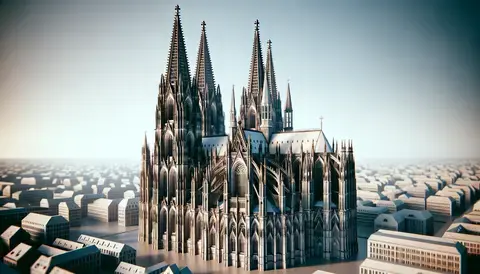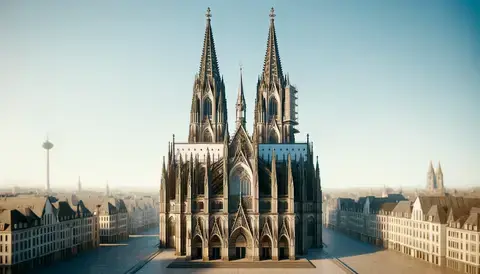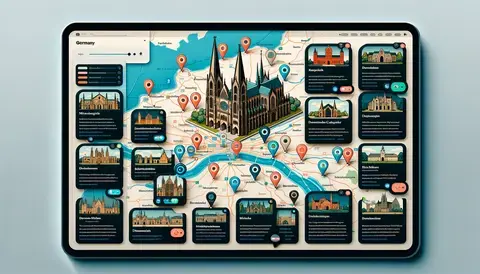Gothic Architecture in Germany | Characteristics, Notable Examples, and Historical Insights

Have you ever stood beneath the towering spires of a Gothic cathedral and wondered how such sky-reaching structures were built over 500 years ago? Gothic architecture, with its awe-inspiring features, not only encapsulates the spirit of medieval Europe but also serves as a testament to the ingenuity and faith of the past.
Gothic Architecture Characteristics, Examples, & Facts: German Gothic architecture is an enthralling study of medieval innovation. Known for its ambitious verticality and spiritual mystique, this architectural style brings together engineering brilliance with ornate aesthetic details.
Exploring German Gothic Architecture: Key Features, Landmark Examples, and Lasting Influence
Imagine walking through the heart of a German city, your eyes drawn upwards by the sheer height of a Gothic cathedral. These masterpieces of architecture, built centuries ago, still dominate the skyline with their dramatic spires and intricate facades. But what is it about German Gothic architecture that captivates us to this day?
In this free 2024 new course about German Gothic architecture, we'll explore its defining characteristics, the historical context of its rise, and some of the most iconic examples that continue to inspire awe. From the structural innovations that allowed these buildings to soar to new heights to the ornate details that speak of a profound spiritual fervor, German Gothic architecture offers a fascinating study in contrasts.
Summary: By the end of this article, you'll have a clearer understanding of how German Gothic architecture differentiates itself from other European styles, the technological and artistic advancements it introduced, and why these structures have stood the test of time. We will examine famous cathedrals like Cologne Cathedral and Ulm Minster, uncovering the stories they tell about Germany's medieval past and their cultural significance today.
The Historical Evolution of German Gothic Architecture
Brief History: Gothic architecture's introduction to Germany in the 12th century marked a pivotal shift from the heavy, solid forms of Romanesque style to a design that emphasized light, height, and heavenly aspirations. Originating in France, the Gothic style crossed into Germany, where it was embraced and adapted, reflecting local tastes and technological capabilities.
Development Timeline:
- 12th Century: Introduction of Gothic architecture in Germany.
- 13th Century: Maturation of the style with the completion of early Gothic structures like Magdeburg Cathedral.
- 14th-15th Century: Pinnacle of Gothic achievements with the construction of High Gothic cathedrals, characterized by ambitious scales and intricate ornamentation.
- 16th Century: The Late Gothic period brings advancements in vaulting techniques and more elaborate, regional variations.
Characteristics of German Gothic Architecture:
- Vertical Emphasis: German Gothic architecture is renowned for its height, with cathedrals pushing towards the sky as if reaching for the divine.
- Intricate Facades: Facades are adorned with detailed sculptures and carvings that tell stories from the Bible and local legends, serving both decorative and didactic purposes.
- Innovative Structures: Features like ribbed vaults and flying buttresses not only supported taller, more graceful buildings but also allowed for larger windows and more light.
- Use of Local Stone: The use of local materials not only gave each structure a unique aesthetic tied to its landscape but also fostered a sense of local pride and identity.
Notable Structures and Their Significance:
- Cologne Cathedral: A UNESCO World Heritage site, it is celebrated for its awe-inspiring twin spires and is a treasure trove of medieval art.
- Ulm Minster: Holds the record for the tallest church steeple in the world, illustrating the ambition and skill of Gothic architects.
Pro Tips for Appreciating Gothic Architecture:
- Look Up: Always take a moment to appreciate the verticality of Gothic structures.
- Details Matter: Pay attention to the details. The facades of these structures are filled with intricate carvings that offer insights into the craftsmanship and artistic priorities of the time.
- Flying Buttresses: When visiting a Gothic cathedral, always look for the flying buttresses—an architectural invention that allowed builders to reach new heights.
- Gothic Glass Windows: Notice the stained glass windows which are not only beautiful but were used to tell stories and educate the illiterate masses during the medieval period.
This introduction sets the stage for a deeper exploration of German Gothic architecture, its distinctive features, and its enduring legacy in the architectural landscape. Let’s continue to uncover the stories these ancient stones tell us, as we move into the next section, which will focus on specific architectural elements and their implementation in iconic structures.
Defining Features of German Gothic Architecture
Architectural Elements: As we get deeper into the unique aspects of German Gothic architecture, it's important to understand the specific elements that define this style. These features not only contributed to the distinctive aesthetic of the buildings but also represented significant technological advancements that influenced future architectural developments.
Structural Innovations and Aesthetic Details:
Pointed Arches and Ribbed Vaults: These are hallmark features of Gothic architecture. The pointed arch helped distribute weight more efficiently than the rounded Romanesque arches, allowing for taller and more slender structures. Ribbed vaulting, similarly, added support and decorative complexity to ceilings.
Flying Buttresses: Perhaps one of the most revolutionary Gothic innovations, flying buttresses allowed walls to be thinner and windows larger, facilitating the famous luminous interiors of Gothic cathedrals.
Gargoyles and Grotesques: Serving both practical and decorative purposes, these sculpted figures channeled rainwater away from the building's foundation while also warding off evil spirits, according to contemporary beliefs.
Stained Glass Windows: Larger than those in earlier styles, these windows were not only sources of natural light but also served as visual storytelling mediums, depicting biblical scenes and saints, which educated the largely illiterate population during the Middle Ages.
Case Studies:
Cologne Cathedral: The cathedral’s massive stained glass windows and the soaring twin spires showcase the zenith of German Gothic architecture’s ambition and skill.
Ulm Minster: Its steeple, the tallest in the world, stands as a testament to the vertical aspirations of Gothic architecture and the ingenuity of medieval engineers.
Expert Opinions: Architectural historian Dr. Anna Weber states, "The structural advancements of German Gothic architecture were not just about aesthetic improvement. They reflected a profound shift in how space was conceptualized and utilized."

Gothic Influence on Contemporary Architecture
Introduction to Modern Applications: Building on the rich legacy of German Gothic architecture, contemporary architects continue to draw inspiration from its principles, adapting its elements to modern needs and technologies. This section explores how the aesthetic and structural innovations of Gothic architecture influence today's architectural landscape.
Contemporary Design Influences:
Verticality in Skyscraper Design: Modern skyscrapers echo the vertical aspirations of Gothic cathedrals, aiming to reach ever higher into the sky. The use of pointed designs and spire-like structures in buildings such as the Chrysler Building in New York showcases this influence.
Adaptation of Gothic Elements: Contemporary architects incorporate modified Gothic elements such as ribbed vaults and flying buttresses into modern structures, using advanced materials like steel and glass instead of stone.
Aesthetic Inspiration: The intricate facades and detailed ornamentation of Gothic architecture find new expression in modern public buildings and luxury residences, providing a sense of grandeur and complexity.
Case Studies:
The Shard, London: Inspired by the spires of London churches and the masts of tall ships, The Shard represents a modern interpretation of Gothic verticality with its tapering design and glass façade.
Milan Cathedral-inspired Shopping Center: In Milan, a shopping center design incorporates pointed arches and vaulted ceilings reminiscent of the city's famous cathedral, blending traditional Gothic aesthetics with modern commercial architecture.
Expert Quotes: Renowned architect Michael Foster remarks, "Gothic architecture teaches us the power of awe in public spaces. Its principles can be adapted to create striking modern buildings that resonate with cultural memory and inspire wonder."
Pro Tips for Architects:
- Incorporate Light and Space: Use large glass panels and open interior spaces to mimic the luminous interiors of Gothic cathedrals.
- Detailing Matters: Small Gothic-inspired details can add a layer of richness and historical depth to even the most modern designs.
Key Takeaways on Gothic’s Modern Influence: The enduring influence of German Gothic architecture on contemporary design demonstrates the timeless appeal of its aesthetic and technological innovations. By studying these historic structures, modern architects can continue to learn valuable lessons about blending functionality with awe-inspiring beauty.
The Enduring Legacy of German Gothic Architecture
Legacy and Cultural Impact: German Gothic architecture's legacy extends far beyond its historical period and geographical origins. This module explores how these medieval structures continue to influence culture, education, and the arts, serving as icons of architectural brilliance and historical narrative.
Cultural Significance and Preservation:
Architectural Icons: German Gothic buildings like Cologne Cathedral and Ulm Minster remain pivotal to Germany’s cultural identity, attracting millions of visitors annually and serving as symbols of national pride and historical continuity.
Preservation Efforts: Ongoing restoration and preservation projects underscore the importance of maintaining these structures not only as tourist attractions but also as vital links to the past. These efforts often employ both traditional techniques and modern technology to ensure authenticity and durability.
Educational Value: Gothic cathedrals are used as educational tools in architecture and history courses around the world, illustrating the evolution of architectural styles and building technologies.
Expert Opinions: Cultural historian Dr. Emily Rausch states, "German Gothic buildings are not merely relics of the past; they are vibrant cultural artifacts that continue to educate, inspire, and attract diverse audiences worldwide."
Interactive Map: An interactive map featuring Gothic cathedrals across Germany, providing historical facts, visitor information, and links to virtual tours for each location.

Key Insights into Gothic Architecture’s Relevance Today: The exploration of German Gothic architecture reveals its profound impact not just on subsequent architectural developments but also on modern cultural and educational practices. These structures stand as testaments to human creativity and resilience, continuing to inspire and teach future generations.
Conclusion
Key Takeaways on German Gothic Architecture: As we conclude this exploration, we reflect on the significance of studying German Gothic architecture. It offers insights into the innovative spirit of the medieval period, showcasing advancements in construction that influenced architectural design for centuries. By understanding these monumental structures, we gain a deeper appreciation for Germany's rich cultural heritage and architectural prowess.
Further Exploration: For those interested in further study, "The Story of Gothic Architecture" by Francesca Prina provides an in-depth analysis of the structural innovations and aesthetic considerations of Gothic cathedrals in Germany. Additionally, online courses on medieval European architecture can offer interactive learning experiences about this fascinating topic.
This comprehensive overview not only highlights the historical and cultural importance of German Gothic architecture but also serves as a foundation for appreciating its continued influence in the field of architectural design.
Gothic Architecture in Germany FAQs
What is German Gothic architecture? Answer: German Gothic architecture is a style of building that emerged in the High and Late Middle Ages, characterized by features such as pointed arches, ribbed vaults, and flying buttresses. It is particularly noted for its dramatic verticality and the light and airy interiors of its cathedrals and churches.
When did the Gothic architectural style begin in Germany? Answer: The Gothic style began in Germany around the early 13th century, following its development in France. The first fully Gothic structure in Germany was the Choir of St. Denis Church, Magdeburg, completed in 1235.
What are some distinctive features of German Gothic cathedrals? Answer: Distinctive features include elaborate tracery on windows, vast stained glass panels, intricate spires, and the extensive use of flying buttresses which allow walls to be higher and windows larger. German Gothic cathedrals often feature a Hallenkirche (hall church) layout, where the nave and aisles are approximately equal in height.
Can you name a famous example of German Gothic architecture? Answer: The Cologne Cathedral (Kölner Dom) is one of the most famous examples. Its construction began in 1248 and, though it was halted in the Middle Ages, it resumed in the 19th century and was completed in 1880. It is renowned for its massive façade and twin spires.
How did Gothic architecture in Germany differ from that in France? Answer: German Gothic architecture is generally more varied and less uniform than its French counterpart. While French Gothic emphasizes height and verticality, German Gothic structures may feature more expansive horizontal spaces and employ a Hallenkirche design more frequently.
What role did the Gothic style play in the cultural context of medieval Germany? Answer: Gothic architecture in medieval Germany was closely tied to the growth of cities and the influence of the Church. It represented both religious devotion and the economic prosperity of the towns. Cathedrals and churches were often the center of municipal life and pride.
How has German Gothic architecture influenced modern building styles? Answer: German Gothic architecture has influenced modern building styles through its emphasis on verticality, light, and the innovative use of structural technologies. Elements like pointed arches and ribbed vaults have been adapted in various neo-Gothic and contemporary designs, reflecting the enduring appeal of Gothic aesthetics.
These questions can serve as a basis for deeper study or discussion about this rich and fascinating architectural period.
